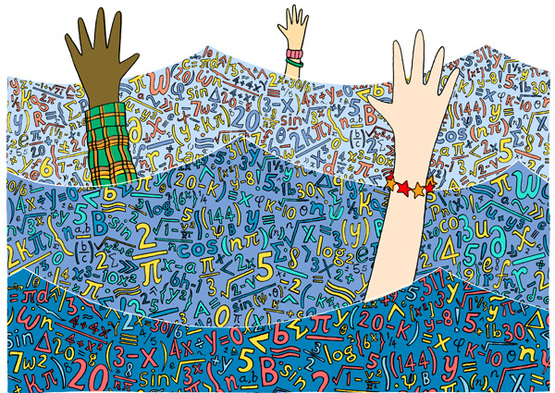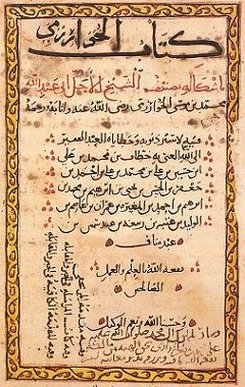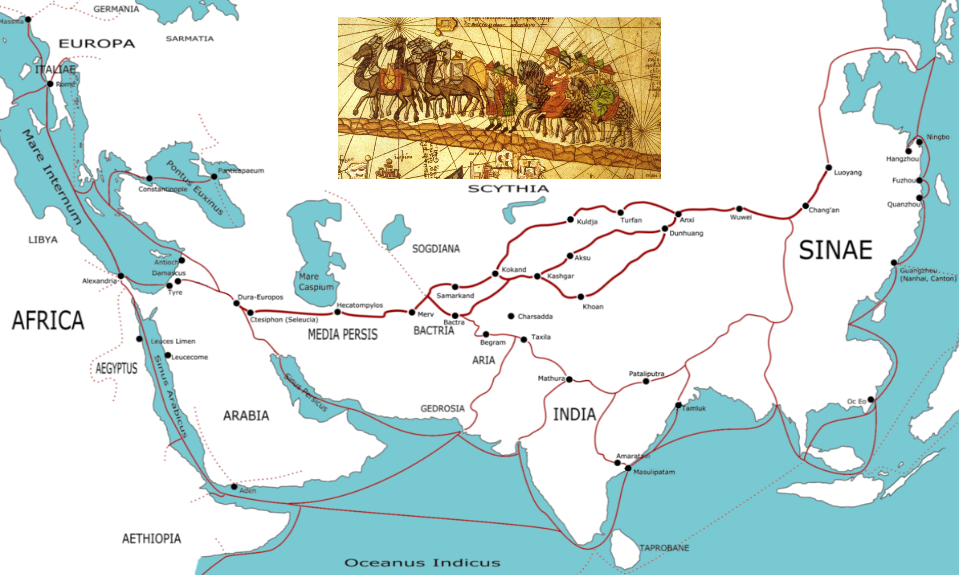Algebra: Restoring the Value of an Unknown Number
الكتاب المختصر في حساب الجبر والمقابلة
al-Kitāb al-mukhtaṣar fī ḥisāb al-jabr wal-muqābala
The Compendious Book on Calculation by Restoring and Balancing
by Muhammad ibn Musa al-Khwarizmi (circa year 830 of the Common Era)
by Muhammad ibn Musa al-Khwarizmi (circa year 830 of the Common Era)
Some middle-school students will complain about algebra, saying, "When will I ever use this in real life?" But algebra was constructed 1,187 years ago as a tool to help solve real-world problems. When Muhammad ibn Musa al-Khwarizmi wrote his famous text, "The Compendious Book on Calculation by Restoring (al-jabr) and Balancing, (al-muqabala)" his examples came from problems like trading between countries with different money and goods, or constructing streets, buildings, and canals in Persia. This was important because Persia was a center of trade as the middle of the route for goods between Western Europe and Eastern Asia.
Variables
Big Idea: In many jobs and tasks in the world, success depends on solving similar-but-not-quite-the-same problems in similar ways. After years--or sometimes centuries--of work, scientists or engineers or bankers or business leaders have created mathematical models that explain how some part of our world, culture, society, or economy works. With this knowledge, they can be confident in the parts of the model that stay the same and concentrate their attention on the parts that vary, or change.
Variables are symbols or letters that people in a certain profession (science, engineering, or business, for example) have agreed will represent the parts of the mathematical model that change. The rest of the equation, the pattern that stays the same, will help find answers for any missing variables.
Variables are symbols or letters that people in a certain profession (science, engineering, or business, for example) have agreed will represent the parts of the mathematical model that change. The rest of the equation, the pattern that stays the same, will help find answers for any missing variables.
Patterns
Big Idea: When there is a pattern to numbers in a series, observers can often use the pattern to figure out relationships between variables.
Equations
Big Idea: The most common way to express patterns between variables is in the form of an equation, a mathematical statement that uses arithmetic operations (addition, subtraction, multiplication, division, and exponents) to show that two amounts are equal.
Constants
Big Idea: While many students and some adults focus on the use of letters or symbols in algebra, many algebra equations rely on the pattern of relationships between variables to identify constants in an equation, numbers that do not change from problem-to-problem.
Formulas
Big Idea: When an equation has been shown to be effective in solving a mathematical problem over time, it is accepted by people who work on that type of problem as a formula that will work for future problems of that type.
Restoring (al-jabr)
Big Idea: making an equation simpler by . . .
- getting rid of parentheses by performing the required operations (usually multiplication or division),
- reducing the terms (individual values or variables) through combining (addition or subtraction),
- gathering or isolating all the variables (unknown numbers, usually represented by letters) on one side (usually the left) of an equation, and the constants on the other side (usually the right) helps make an equation clearer.
Balancing (al-muqabala)
Big Idea: a mathematician can add a number to an expression, or multiply an expression by a factor, as long as the the same operation is applied to both sides of the equals sign.
- Multiply both expressions (sides) by the reciprocal of the coefficient (the number multiplying the variable). This is the same function as dividing by the coefficient. This is often a good strategy when fractions are part of one of the expressions.
A statue of Al-Khwarizmi in front of Baghdad's House of Wisdom Museum.
Baghdad, Iraq
Baghdad, Iraq
Muhammad ibn Musa Al-Khwarizmi wrote other valuable books on geography, astronomy and numerals as well. His Latinized name Algoritmi (from al-Khwarizmi) in later translations give us the words--
Algorism--the placement of digits in place-value positions and using powers of 10 (10, 100, 1,000 . . . ) to describe them.
Algorithm--in computer science and higher mathematics, a step-by-step set of operations to be performed the same way in response to certain starting conditions to get a result.
Algorism--the placement of digits in place-value positions and using powers of 10 (10, 100, 1,000 . . . ) to describe them.
Algorithm--in computer science and higher mathematics, a step-by-step set of operations to be performed the same way in response to certain starting conditions to get a result.




